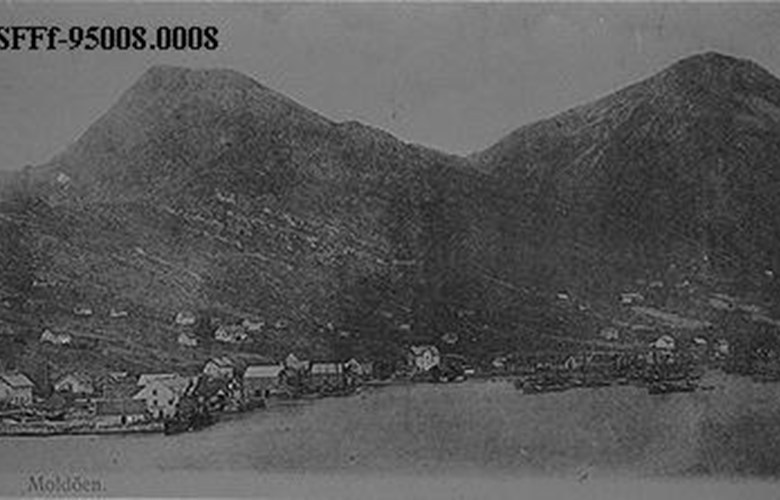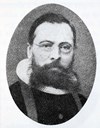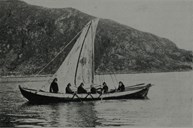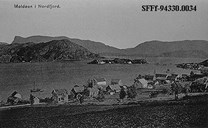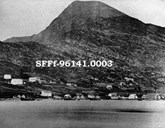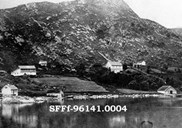Vågsøy municipality
In 1905, Vågsøy ¿sokn" (sub-parish) was part of the municipality of Selje. As of 1 January, 1906, this ¿sokn" was split into Nord-Vågsøy and Sør-Vågsøy. Nord-Vågsøy had at that time a church at Røysa, whereas the Sør-Vågsøy church was not consecrated until 5 September, 1907. From 1 January, 1910, these two church ¿sokns" were separated from the municipality of Selje to become municipalities in their own rights. During this work, a conflict arose as to the border between the municipalities of Nord-Vågsøy and Sør-Vågsøy on the eastern side of the island of Vågsøy. The dispute had to do with the deserted farm of Blesrød which eventually ended up within the borders of Sør-Vågsøy. On 1 January, 1953, Vågsøy became a separate parish, separated from Selje. The new parish comprised the two church ¿sokns" of Sør-Vågsøy and Nord-Vågsøy.
On 1 January, 1964, the two municipalities of Nord-Vågsøy and Sør-Vågsøy were united and got the new name of Vågsøy. The island of Silda and the farms on the peninsula between the strait of Ulvesundet and Sørpollen, as well as the farms of Sørpollen and Straumen were transferred from Selje to the newly established municipality. At the same time, the north side of the Rugsund ¿sokn" and the islands of Risøy, Gangsøy, Grindøy, Husevågøy and Klovningen were transferred from the municipality of Davik to Vågsøy.
Population growth after 1905 in Selje and Vågsøy
In 1900, the population of Hove ¿sokn" was 3235 and in the Vågsøy ¿sokn" 2222. Hove ¿sokn" corresponds to the Selje municipality after it was split up in 1910. The many border regulations make it almost impossible to follow the population trend in this area up to the present time. However, we can choose another starting-point by using the munipality borders of 2001 and then look at the development in these areas from 1900 to 2001. These figures are available. Inside the 2001 borders the population in 1900 for the Vågsøy area would have been 3850 and for the Selje area 2783.
In what is the present area of Selje, the population increased from 2783 to 3286 in 1920. After this year, the population figure was relatively stable until 1990. Then it fell dramatically to about 3000 in the course of 11 years. In Vågsøy, on the other hand, the development was quite different. From a population figure of 3850 in this area in 1900, it rose steadily and strongly to some 5000 in 1930. The growth continued and in 1950, the population had risen to 5946, and the following decade saw an unusual population boom in the municipality of Vågsøy. In ten years, the population increased from 5946 to 6927 in 1960. Since that year the population has decreased somewhat, but has been relatively stable with about 6400 people up to 2001. Vågsøy experienced a substantial growth period, but this was not the case with Selje
Trade and communication
The most important trading centres in 1895 were Måløy, Skram and Raudeberg. There were sub-post offices at Måløy, Vågsvåg, on the island of Silda and at Raudeberg. Telegraph stations and telephone exchanges were established at Måløy, Raudeberg and Osmundsvåg.
From Raudeberg there was a road to Vågsøy on the eastern side of the small lake of Refviksvatnet. There was also a road further out past the Kvalheim farms to Ytre Myre. A road was also under construction from Raudeberg past the church to Sæter. A new rural road was built from Setenes to Gauteberg, and from Vågsvågen to Torskangerpollen. The total length of the roads in this area was 59.4 kilometres.
Fisheries at the turn of the century
We have information from the whole municipality of Selje before it was split up. The local fisheries were important in many places in this area. The spring herring was caught with seines and nets on the northern side of Stadt, by the island of Silda, as well as many places on the island of Vågsøy, for example in the bay of Torskangerpollen. This fishery lasted from Candlemas (2 February) until mid-April, and the herring arrived at the coast every year on a regular basis. In 1899, the herring fishery was exceptionally good. Each fishing boat had 18-24 nets and a crew of six men. The summer herring arrived eight days after Midsummer Day (24 June) at Nordpollen, Sørpollen, Raudeberg, Deknepollen and Refvika. The autumn herring came in October and November, largely to the same waters as for the spring herring. In the summer months sprat and small herring were also caught. On Candlemas they rowed out to fish "skrei" (spawning Arctic cod), a fishery that usually lasted until mid-April. In those years, significant changes were taking place in the fisheries. New boats and improved technology were introduced in the industry.
If we use the figures for 1899 and look at the income from the various fisheries, we can get an impression of the economic value this industry represented. In 1897, the total value of the fisheries in the Selje- Vågsøy area was 2.3 million 1897 kroner. Today this sum corresponds to 70 million 2004 kroner. In 1899, 1620 fishermen and 323 boats had taken part in the "skrei" fisheries.
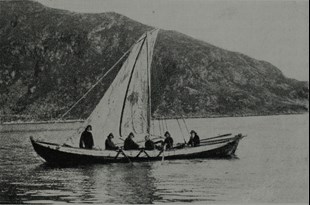
"An old prejudice"
On 24 May, 1905, the local paper Fjordenes Blad reported of good fisheries at Tampen (fishing bank northeast of Shetland). "Our fishing boat steamers have made excellent catches at Tampen. Average catches 1500 ling and some torsk. Last week the boat "Skallagrim" was best with 1700 ling and this week probably "Kveldulf" with 1600. The deck boats also did well, even if fishing was somewhat hampered by fog." On 30 August, the same paper reported of good catches for the fishing boat steamers.
"Fishing boat steamers came back last week with good catches. A couple of boats came in on Saturday with fair catches. When the number of boats was so low, this has to do with an old prejudice that still exists. According to this prejudice, the fishing of ling and torsk should be over by Midsummer. With the old, primitive and open boats, they thought it unwise to make any major efforts. Now fishermen have modern deck boats that are much more seaworthy, but still the old prejudice remains.
Nevertheless, this fishery will develop and will give a good and steady income. At Barmsund seine catches of mackerel seem to be promising. The catch last week was reported to be 200-300 "mål". The price is 20-24 kroner per "mål". (one "mål" is about 50 litres)
Good friends in Bergen.
Ulf Lem was a prominent businessman at Måløy at the turn of the century. On 23 August, 1905, Fjordenes Blad reported from the 25th anniversary of Lem's business activities.
"On 16 August, many guests from Moldøen and elsewhere had arrived and spent the evening with the host in the most cordial atmosphere. "Nordfjord" came north with friends from Bergen in the afternoon, "Vestfjord" sent up a colourful fireworks, at the same time as fireworks were sent up from land, sponsored by local businessmen. At the dinner table, the toastmaster Mr Christian Krohn from Bergen rose from time to time to read telegrams from near and far as they arrived. Teacher Kvalheim turned up outside Lem's house with the chorus and sang a couple of nice songs.
After Mr and Mrs Lem had received a fair number of compliments, even in versified form, on the 25th anniversary as a businessman at Moldøen (Måløy), the party was over close to midnights with thanks offered to the excellent hosts."
Which is best - Måløy or Florø
Florø and Måløy have been rivals in many fields. Today they are our coastal towns. The paper Nordre Bergenhus Amtstidene of 31 May, 1905 ran an article on the subject of this rivalry that we quote verbatim.
"It has been predicted that Moldøen with time would get the upper hand of Florø, particularly because of a more convenient location. Moldøen is situated by the shipping lane and all coastal traffic passes the strait. In addition, the place is a natural transit harbour for the fjord traffic. Both these factors are less prominent at Florø, but Florø, on the other hand, has such a head start as a town that it nearly makes up for the excellent location of Moldøen.
However, we shall not dwell on this any longer. There is another aspect that people are very much preoccupied with these days; namely, the situation of Moldøen and Florø in terms of the fisheries. Whereas Moldøen has just as many fishing boat steamers as Florø, up there they have a fishing fleet consisting of about 40 decks boats and fishing boats (partly with engines), when we (at Florø) cannot match this. Even more conspicuous is the way the fisheries are carried out.
A report to "B. Aftbl." says that crewmembers on fishing boat steamers at Moldøen in the course of the past couple of weeks have earned between 100 and 150 kroner each. Meanwhile, Florø's fishing fleet has been lying idle since long before Easter. There may be many factors to account for this. We admit that we do not have enough knowledge of the circumstances to say something about the causes. Nevertheless, it is rather strange that we (at Florø) cannot muster the same entreprise as they do at Moldøen. Distance plays an insignificant or no role as the distance to the fishing grounds is practically the same from either place. Capital? In this respect, Moldøen comes second. Enterprise? Perseverance? Well, there must be something, and it is time to find out.
Florø is located in the archipelago. People there have always had high hopes and expectations of the fisheries, and these represent the future of Florø. This fact cannot be explained away. If people want prosperity and progress, they have to pull themselves together to run efficient fisheries.
It has been said that people from Nordfjord are more dynamic than people from Sunnfjord. Maybe - maybe not. But if we make comparisons between Moldøen and Florø, there is some truth in it. At Moldøen fisheries are carried out by four-five steamers (average income for each crewmember of 100 to 150 kroner) and 40 sailing vessels. Busy times for workers. Hustle and bustle everywhere.
Florø has five fishing boat steamers. One is bankrupt. The others are moored week after week. Nothing happens, when all the while Swedish boats haul in catches of fish out on the fishing banks, or take the catches in to Moldøen, where one shipment after another is sent south, past Florø. Things could have been different, and something has to be done. Empty words have no effect. Fish will not be lured in to the city with nice words. It has to be caught out there. But if this is done, it will mean money, profit, hustle and bustle, busyness - progress. Energy and enterprise are needed. Otherwise all means or capital will be in vain."
Shipwreck in the strait of Måløysundet
In February, 1905, the steamer "Sjøgutten" from Stavanger was on her way north through the strait of Måløysundet. The steamer was loaded with 700 tonnes of bricks destined for Ålesund. It was snowing heavily, and at 9am, the boat ran aground. At noon, she sank to a depth of 30 feet "cutting five cables on her way down. The boat is lying across the recently laid telegraph cables from the mainland to the island of Vaagsøen. The Nordfjord cable is already cut. The sunken boat is positioned in such a way that it may cause problems for the traffic through the strait. Divers have been called in from Bergen to assist in the rescue operation. The crew was saved."
The cargo was taken up in the spring and there was a brisk sale of bricks. The steamer was brought up to the surface and the engine was still in good working order. In early June, the steamer proceeded from Måløy under her own engine, escorted by two diving support vessels. "The departure was fantastic with sirens blowing from steamers and shot fired from land, with waving of handkerschiefs and flags."
Ice from eastern Norway
The fishing industry at Måløy needed ice, and Lem, Lefdal and Søreide, who all owned fishing boat steamers at Måløy, received a cargo of ice on a steamer from eastern Norway "huge blocks of ice that would certainly withstand the summer heat for a while."
Later in the summer, it was time for haymaking. Farming was also important in the municipality, but news from the fisheries and the sea dominated the newspaper columns. Fjordenes Blad reported on 29 July: "Haymaking was now in full swing in this area. However, because of all the rain it is hard to get the hay into the barn. It looks to be an exceptional year for hay production. We are still waiting for the summer herring, but we have to content ourselves with the fact that the prospects are good. Another incident was reported today that a deck boat - probably a fishing boat - had lost the rudder off Kraakenes. Fortunately it happened so close to land that the anchor could be used and the boat got the necessary assistance from land."
Swedish fishermen at Måløy and the union
The newspaper Fjordenes Blad on 24 June, 1905, ran a very interesting article about Swedish fishermen at Måløy.
"About 20 years have passed since Swedish fishermen started to fish on the banks here with Moldøen as their station. Previously they had been stationed at Aalesund. About 200 men on about 20 boats have arrived here every year just after Easter, just as regularly as the greylag goose. Small boys can recognize the boats at long range, and interested as all young people of Moldøen are in everything that has to do with the sea, they jump onboard, even before the anchor has hit the bottom, where they are given big, round, hard wheat buns the Swedes have brought with them as provisions.
During the flag issue in the 1890s, but particularly now during the conflict in the past couple of months, there have been "political discussions". The coastal population of Sweden has on the whole little or no knowledge of politics. It does not know the requirements for the right to vote, and quite a few people do not even know whether they themselves have this right. One thing they know for sure; "Norway lies under Sweden".
One day when the topic of war between Sweden and Norway was brought up, one of the Swedes, backed by his friends, said: "No, Sweden will not start a war: there is nothing to fight about as Sweden already has Norway."
An elderly, reliable gentleman from Geiranger - Ingebrigt Nødhjelle at Davik - told me a month ago that a Swedish lady, married to a now deceased merchant in Aalesund, stayed with him in the summer holiday. The woman, who was from Gothenburg, said: "It is true - at Swedish schools pupils learn that Norway is a dependency under Sweden."
What is worst is the fact that a majority of the Swedish population thinks that Norwegians for a long time have been planning to attack Sweden. However ridiculous this belief is, many people still believe it.
Under these circumstances, it is no wonder that the union was dissolved. On the contrary, it is a wonder that the union lasted so long. It is also strange that the Swedish authorities in a country so rich in large arable areas, magnificent forests and mountains full of mineral resources, should not have anything better to do than constantly to fall out with Norway.
Let us return to the Swedish fishermen. They are all modest and righteous men who throughout all these years have never had any debt, temperate - I have not yet seen a drunken Swede - and they write letters to their girlfriends back home, without being tempted to seek new acquaintances here.
Associations and organizations
The area that constitutes today's municipality of Vågsøy had a high number of various organizations. About 35 associations and organizations were established either before or in 1905. The biggest group was made up of mission associations and various women's organizations. Every single hamlet had one or more organizations working for mission activites or other Christian purposes. We find a number of youth associations at Maurstad, Vedvik, Raudeberg, Skavøypollen, Skram and one called "Dæmring" Some temperance associations were also established in many places. In the years leading up to 1905, there was an increased interest in rifle activities, and the following associations were established about 1890: Skavøypoll, Bryggja, and Almenning. There were choirs at Refvik/Vedvik and at Måløy there were plans of starting a brass band. It was established the following year.
17 May, 1905 on the fishing ground of Tampen
All over the country, people celebrated 17 May with extra enthusiasm that year. The following day the law proposal concerning a special Norwegian consular service would be debated in the Storting (Parliament).
Fjordenes Blad reported that 17th of May had even been celebrated at Tampen. "This year all the fishing vessels hoisted their flags. In the morning, it was thick fog so they could not see one another. Later on that day, the fog lifted, and soon the whole fishing fleet was "dressed for a party". Some even fired shots into the air."
The newspaper also reported that "Ole Gangsøen on the 17th of May had bought a new modern fishing boat for the summer fisheries. We would like to congratulate Mr Gangsøen and wish him luck. Would it be wrong if Ole Gangsøen named his new boat 17 May?"
"17 May celebrations at Moldøen"
On 24 May, 1905, Fjordens Blad reported of an especially fine 17 May celebration at Måløy. "The 17 May festivities at Moldøen were attended by huge crowds. At 6 am sharp, 21 shots were fired from Gotteberg, Midtgaard and Sæternes (seven from each place). Now and then shots could also be heard from the mainland at Kulen and Degnepold. The honour of firing the first shot on 17 May, 1905, most likely goes to the orchestra conductor v. Severen who fired a gun ten minutes past midnight. After the Skram youth association and the lodge "Havglimt" had unveiled their banners, the procession started at 1pm. From the schoolhouse to Gotteberg, from there to Sæternes, and return to the school premises where the pastor Klausen gave the speech for the day. The conductor v. Severen delivered a speech for the king.
At 6 in the afternoon, everybody met once more at the schoolhouse, where Kr. Sunde gave a speech for the youth, with particular reference to the Skram youth association. All the speeches were warmly received. Next Klausen spoke for the temperance movement. The official part of the celebration was concluded by the words from Kr. Sunde when he asked people to commemorate the 60th anniversary of Wergeland's gift to the municipality of Eidsvoll on 17 May, 1845. The speaker quoted from the inscription on the silver cup:
"Wish the 17th of May, the most blessed of days, forever must return more beautiful".
Sunde then expressed his gratitude to the organizing committee for its excellent work and the the choral society for its performance. This was addressed to the committee chairman Søren Vederhus and the teacher H. Kvalheim. Among the songs that were sung were the national hymn, the national anthem and the royal anthem.
The whole village and all the fishing boats in the harbour were decorated with flags and banners. Shots were fired as the procession moved forward. In the evening people had much fun playing various types of games.
Our appreciation to everybody who took part to make this day of freedom a day of celebration! Special thanks to the organizing committee for their substantial contribution."
7 June, 1905
7 June, 1905, the very day when the union was dissolved was a Wednesday and an ordinary working day, but people were anxiously waiting for the latest news from the capital and the Storting. As the news spread, people hoisted flags, and in some places, telegrams were sent to the authorities to show their appreciation. The Storting issued a proclamation on the dissolution of the union. The Ministry of Church Affairs sent an appeal to the vicars to read an announcement in the churches on the following Sunday - Whit Sunday - on 11 June, or later. This appeal was most likely read at Måløy as well.
The referendums - the right to vote and the election board
There were two referendums in 1905:
Sunday 13 August, when people were asked to say yes or no to the dissolution that had been resolved by the Storting on 7 June.
Sunday 12 and Monday 13 November when people were asked to say yes or no to whether the Storting should choose a king. In reality, this was a choice between monarchy and republic.
On 13 August, the nine members of the election board gathered in the Selje church. Bailiff Hartmann was chairman. The voting would take place in the three churches. "In the Vaagsø church for the whole of the Vaagsø "sokn" and the last mentioned farms in the Stadt "sokn". In the Leganger church for the voters who are registered in the election rolls from and including the farms of Sandvik Nordre and out to and including the farm Austemyr. In the Selje main church for the other farms in the Hove "sokn", apart from the farms Strømmen, Sørpold, Reinen, Osmundvaag, Hjertenæs, Uren, Tvendesæter and Hagevik."
The August referendum - yes or no the dissolution of the union
Dean Strømme had said that if someone wanted to vote no, he would look upon this man as "somewhat of a traitor". There was actually a person who defied Strømme and voted no in Selje/Vågsøy. Three men voted no in the whole county, two in Sogndal and one in Selje parish. "996 votes were counted and they were all accepted unanimously. The counting showed that 996 had voted yes and one person had voted no. The ballots and the absentee declarations were then sealed and kept by the chairman of the election board."
There were 1109 men in all who had the right to vote in Selje and Vågsøy. 1015 votes were cast and 18 of these were rejected. The turnout in Selje and Vågsøy was thus 89.9%; fairly close the county average. The result for the county of Sogn og Fjordane: 16 819 had the right to vote. 16 718 (88,7 %) accepted votes. Only three men voted no.
The result for the whole county: 435 376 had the right to vote, 368 392 accepted votes, 368 208 yes, 184 no.
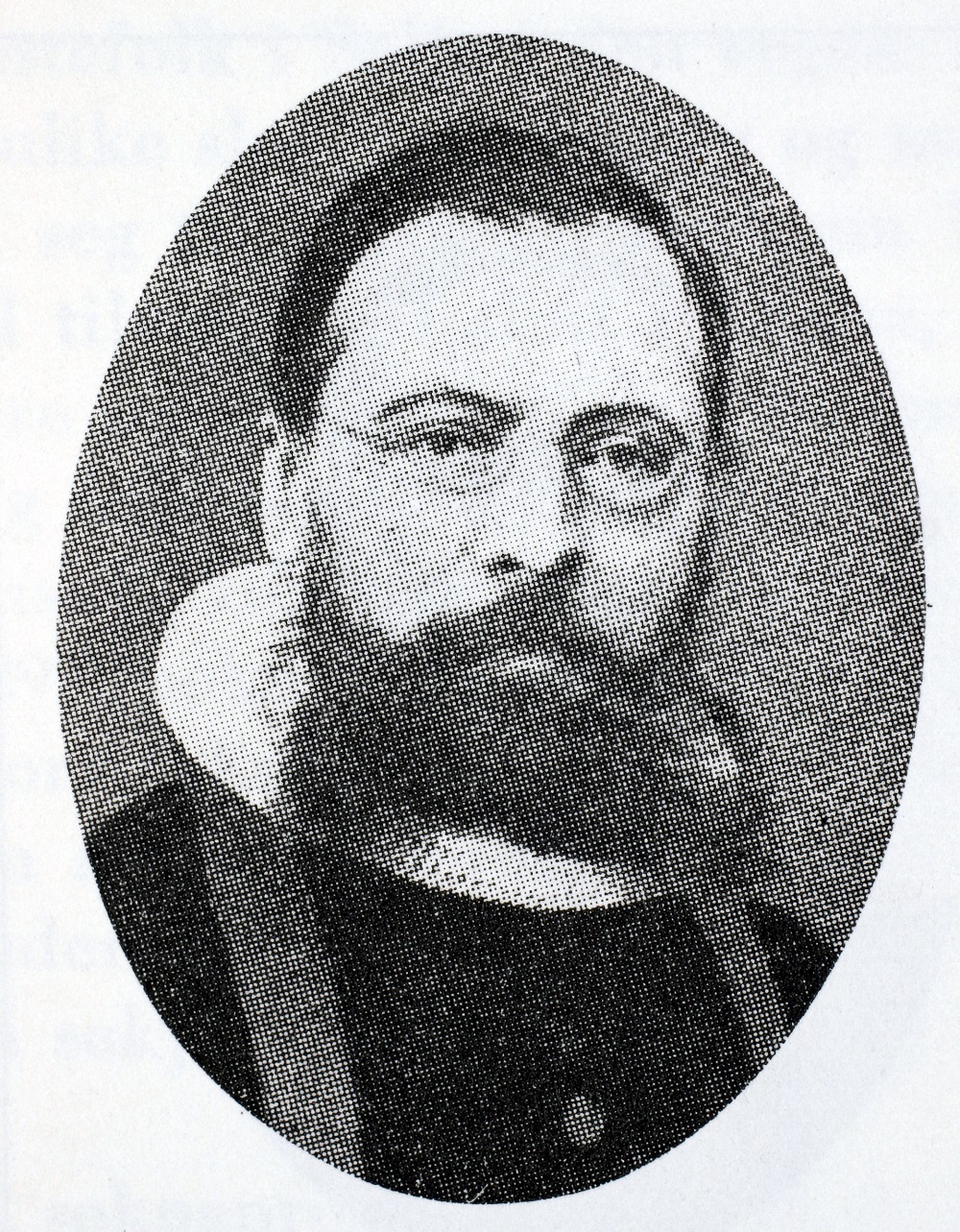
13 August at Vågsøy
Two days before Election Day, Ulf Lem and Ulvesund Fishing Company placed their two steamers at the disposal of the election committee. "Ruth" went to Vågsvågen, calling at Hollevik and "Kveldulf" went to Skavøypollen to pick up people from the mainland. Side by side these two boats came gliding north through the strait of Ulvesundet. The village was decorated with flags. "Skjold", "Skallagrim" and "Egil" had sailed in towards Davik and Rugsund to be of assistance there. Men and women had decorated the Røysa church. There were bands of heather on the pulpit and on the two columns by the entrance to the chancel. Between these two columns the words 17 August 1905, in the shape of heather flowers. High up there was a big Norwegian flag. Twigs of birch could be seen behind each corner of the flag. The signature S-e filed the following report in Fjordenes Blad:
"From the pulpit solemn speeches were given on the significance of today's election, and the cantor used the opportunity to ask those present to remember this solemn occasion. At noon, the national hymn and other patriotic songs were sung. At 12.45pm, the church bells started to chime, at the same time as the flags were hoisted on the flag poles placed at the entrance to the churchyard for the occasion. On a small round table in the chancel, a ballot box was placed with an inscription: "Referendum at Vaagsø 13 August 1905". The members of the election committee sat around the table, wearing ribbons in national colours across their chests. The Constitution's §§ 50-53 and the Storthinget's resolution of 28 July were read.
At 1pm, the chairman of the election committee stepped forward and asked the people assembled there to sing the first stanza of the national anthem. Everybody rose and sang: "Ja, vil elsker dette landet".
At 3pm, the voting was terminated, and the huge crowd returned home, one memorable event richer, for most people more of a fairy tale than an event that actually had taken place. Is it possible that this "Ja, vi elsker" we sang today is the same as the one fools and pranksters used to sing at meetings and parties, - and this flag, flying today on a Sunday above the high altar of the Røisen church, could it be the same as the flag we used to drag along across mountains and along the shores to various meetings and 17 May parties to be derided by all grown-up people - a fairy tale"
This description speaks volumes of how the voting was marked and what kind of atmosphere and solemnity this created.
The November referendum - monarchy or republic
On 12 and 13 November, the people of Vågsøy were to vote yes or no to a monarchy. 1125 men had the right to vote this time. 945 votes were cast, four of these were rejected. 892 thought the solution to have a Danish prince was the best, whereas 49 men in Selje and Vågsøy rather wanted a president for the country. The turnout this time was 83.5%, which means that there was less interest for this referendum than for the one in August. Selje and Vågsøy was one of the most "royalistic" municipalities in the county. Overall, it seems as if the monarchy found the strongest support along the coast. Further into the fjords, more people seemed to prefer a republic.
The result for Sogn og Fjordane: 18 278 had the right to vote, 14 315 (78.3 %) accepted votes cast. 11 507 (80.4%) voted for monarchy, 2 808 (19.6 %) voted for republic.
The result for the whole country: 331 833 had the right to vote, 244 124 accepted votes (73.5%). 194 189 (79.5%) voted for monarchy, 49 935 (20.5%) voted for republic.
The new royal family
On 18 November, the Storting chose Prince Carl of Denmark as King of Norway. He was married to Princess Maud from England, and they had a son named Alexander. Prince Carl took the name Haakon VII and the son got the new name Olav. The new royal family came to Kristiania (Oslo) on the Norwegian naval vessel "Heimdal" in the evening of 25 November, where they were met by a huge and festive crowd. Many telegrams were sent from all over the country on this occasion. We do not have any documentation of this from Vågsøy. In many places throughout the country, festivities were organized to mark the eventful year with independence and a new royal family.
"Parties day in and day out"
In many places throughout the country, parties and festivities were organized to mark the eventful year of 1905. We do not know for certain of any events like these in Vågsøy, but there is reason to believe that such parties took place there as well. In late December, Fjordenes Blad ran a lengthy article on Christmas at Måløy.
"Christmas is a time for parties and festivities. It does not matter that this past year has so far had its fair share of parties, but many organizations still insist on having their Christmas parties. For those who are lucky enough to be members of many organizations and associations, this means that there are parties all the time, coffee and cakes day in and day out.
This year has been particularly eventful, significant events that we hope will be of benefit to our country. On the other hand, the year has also brought many disappointments in one way or another. In the past few months, many of our brave seamen have lost their lives at sea, without being able to send a last farewell to their dear ones at home."
The year 1905 was drawing to an end in Vågsøy. From five minutes before midnight on New Year's Eve until ten minutes past, the fishing boat at Måløy used to sound their whistles to mark the end of the old year and welcome a new year. This was probably done on New Year's Eve 1905/1906 as well.

